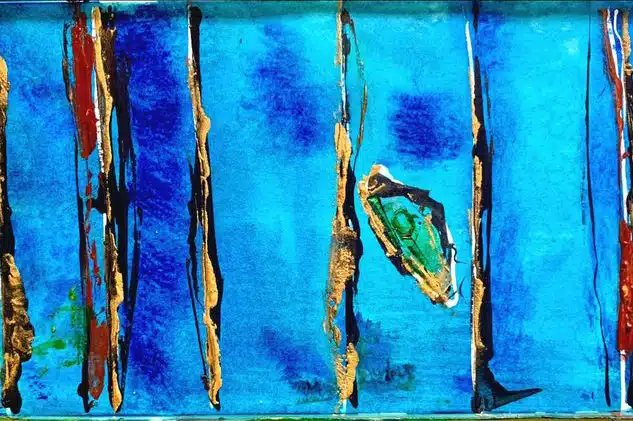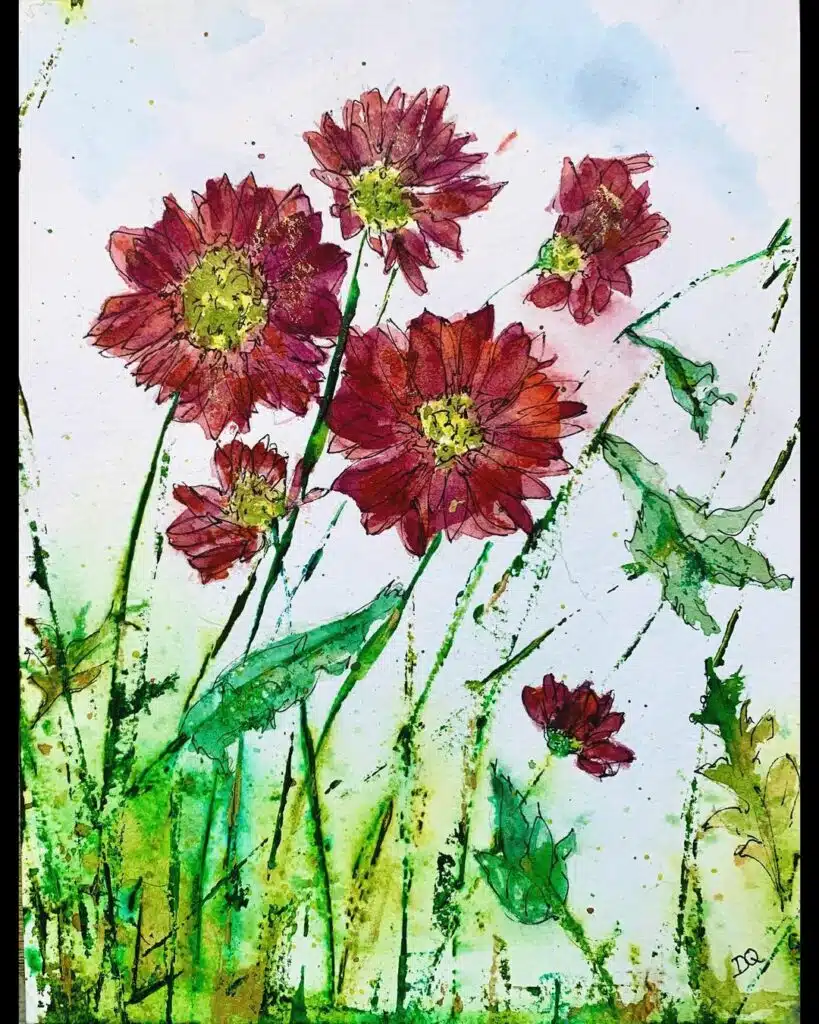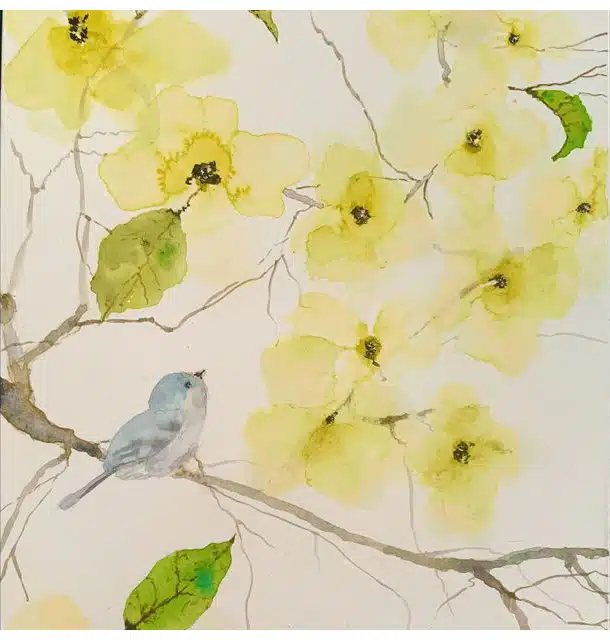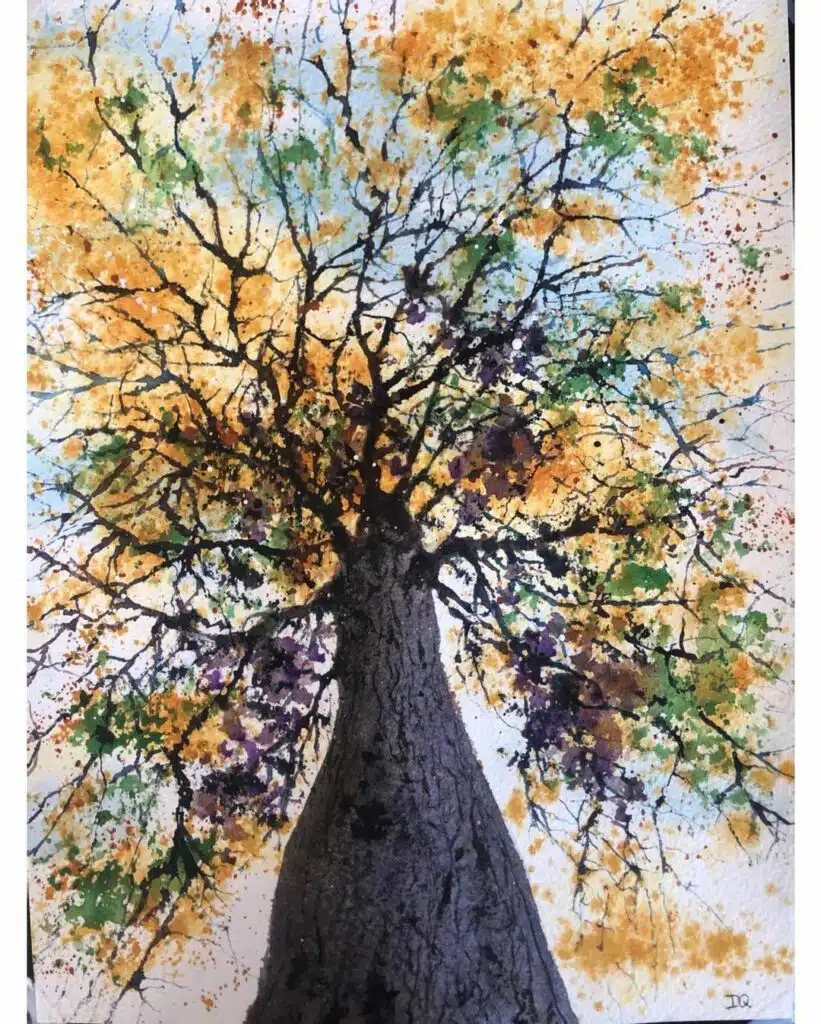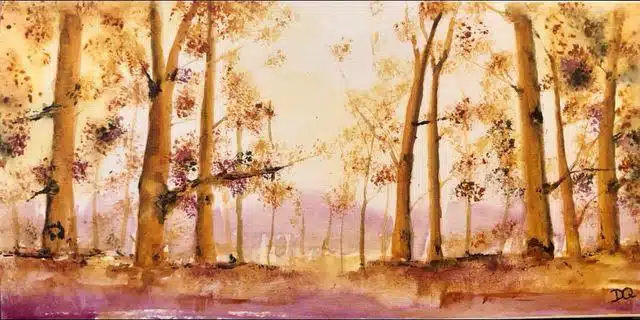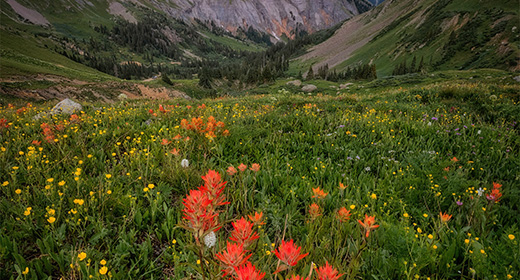by Donna Quesada: I remember the first time I water-colored. My best friend came over one night with some tubes of paint
 and a couple sheets of huge, cardboard-like paper. It was part of a college project, she said, and invited me to have a go. I had no idea what I was doing, but I remember being transfixed by the way the colors mixed and swirled together with the addition of water. That was over 30 years ago and through those years, I have not only found water-coloring to be a wonderful healer, but a holder of great wisdom, which I have distilled into seven bite sized bits, below.
and a couple sheets of huge, cardboard-like paper. It was part of a college project, she said, and invited me to have a go. I had no idea what I was doing, but I remember being transfixed by the way the colors mixed and swirled together with the addition of water. That was over 30 years ago and through those years, I have not only found water-coloring to be a wonderful healer, but a holder of great wisdom, which I have distilled into seven bite sized bits, below.
1. Know When to Stop—
In watercolor… if you mess with it too much, the colors get over-blended and the whole thing becomes “muddied.” A suggestion is often more than enough. No need to fuss and overwork your point. A light touch has a kind of magic about it. Get in and get out.
Like in life, it’s so easy to overdo things. As a philosopher and teacher, I have seen this in my own tendency toward thorough and detailed answers to questions, not only in the classroom, but in day to day life. It hit home when one of my spiritual teachers said to a small group of Yoga teachers once, in a masterclass, “you don’t need to over explain.”
Sometimes… for example, in a courtroom, we need complete and protracted presentations and arguments, but in life, simple is often the most elegant approach. Know when you’ve said enough and leave it alone. Just as the colors blend themselves most beautifully once they’re already on the paper, ideas and words spoken are best digested and reflected on by the listener, with time… in the space of their own silence… without us hammering the point. The Tao Te Ching takes this approach with its poetic entries that continue to ripen with meaning with every re-read.
2. Let go of control—
In watercolor… you can never create the same thing twice. That’s because you never have complete control over the way water moves. Or over a dozen other factors, like the humidity in the room, which will affect the way your painting settles and dries.
Like in life, mostly all we really have at our disposal, is our experience. Which gives us deftness and good judgment… We can take a better guess; I know what will happen if the paper is too wet or too dry, etc.
In every situation, you do what you can, and leave the rest to the universe. Because anything else is a lie. We think we control more than we actually do. I remember someone asking my Zen teacher about this letting go business…“but what if you want to go to law school?” he asked, expecting the Roshi to validate the need for excessive poking and prodding. The Roshi’s response was to the point: “fill out the form.” The assumption is that you do your best; with proper effort, you’ve gotten yourself to this point, and now it’s out of your hands.
3. It’s (More Than) Okay to Screw Up—
In watercolor, you can’t dip a rag in linseed oil and wipe away a bad painting. Yes, you can scratch off little things with a scraper brush or find a way to creatively camouflage a little mistake. But, with watercolor, those fixes reach their limit quickly. I have “wasted” many pieces of expensive watercolor paper.
But I have come to see it differently. It is not wasted. It’s “putting in your time.” It’s “paying your dues.” After all, how much would you spend on lessons? Consider the throw-aways as the price of experience. There is really no other way to get here, without trudging through the swampland of growth.
Think of “bad relationships.” Rather than seeing them as failures, recognize that through them you came to know your own needs better. It’s wonderful. It’s as Esther Hicks says about those Step One moments (the act of noticing the unwanted things in your life)… you have to know what you don’t want in order to know better what you do want. For a more specific example… through that relationship with the narcissist, you learned that you require more thoughtfulness from a partner.
In short, the lost paintings in the bin are just as important as the successful paintings (knowing what doesn’t work is just as important as knowing what does work, in cultivating any skill).
4. Things Always look Different in the Morning—
With watercolor, the pigment gets absorbed, right along with the water. So, as the painting dries, the colors appear more muted than they appeared to be while wet. In other words, once the painting has dried and settled, it will look lighter in color. The colors will also continue to blend as it dries. So, when you look with fresh eyes in the morning, the painting you thought was a goner may surprise you! It’s like finding something new. (It can go the other way too!)
How often has this happened in life… We get ourselves worked up over something, only to see it differently and with a more understanding perspective under the light of a new day. For example, you realize that what was said, was said out of fear by the other person, and not with the intent to be hurtful. It was about them… not you, at all.
The point is… Don’t be too quick to conclude! See how it looks with fresh eyes, in the morning.
5. Progress Isn’t Visible Except in Retrospect—
In all artistic endeavors, the creative charge comes in surges. Known as “writer’s block,” among writers, the gaps between surges can make us feel as if we’re all dried up! Worse, like we’re inept and can’t perform in our craft. But, then you get a glimpse of your early work, and it dawns on you that your perspective is distorted. You see how far you’ve come when you compare it against your current stuff.
You don’t recognize your progress until you look back. And that is because we are all works in progress, in every way. Do we ever really “master” anything? Medicine is a practice. Spiritual practice is a “practice;” not an “accomplishment.” Take meditation, for example. How can you ever master it, when the mind is the way it is? Some days you’ll be more settled than on other days. So, it’s all a part of it… the good days and the bad days. And then you get to a point where there’s no judgment about it at all. You just practice.
But then at some unexpected moment, say, in traffic, or some other situation which would have ordinarily left you frustrated, you suddenly look at yourself, as if witnessing yourself from outside your body… and you say, with some amusement, “Wow! That woulda pissed me off a couple of years ago!” Must be the meditation, you think. It has yielded fruit in a most surprising and subtle way. You never saw it happening, any more than you saw yourself aging. You only see it in intervals. And especially, when looking back, at old pictures.
It’s also that our expectations are higher as we progress, so we’re less impressed with what so easily impressed us at the beginning. This is when, as the Zen saying goes, Beginner’s Mind serves us well… To be able to dive in without the self-censorship that comes from knowing better. In the beginning, we knew no disappointments in our work… we were just having fun! But as “experts,” we’re constantly getting in our own way, with our hefty expectations and difficult-to-please selves.
The take away on this one is… you have improved immensely, you just don’t see it yet! But also, have fun…remember that spirit of abandon that you had in the beginning. Because if you’re not having fun, then why do it?
6. Patience Really Is a Virtue—
In watercolor, when working with wet paper, it’s often helpful to wait for it to dry just a bit to see how the paper is absorbing it, as different papers will soak up water differently, depending on certain variables, such as the weight of the paper and the humidity in the room. You may need to wet it a second time, so that it penetrates, and then then wait again, so that it’s not too wet on the surface.
It’s an opportunity to be meditative. But sometimes life makes us impatient and it’s easy to rush through this process.
Recently, my old neck injury was acting up and it became very difficult to paint, even with the easel. As a result, I was approaching things in a hasty way and I wasn’t taking my usual care with my paintings. I knew I shouldn’t spend much time with my neck crooked, so I was rushed in my approach. The best thing to do was give myself the time to rest and come back when my neck felt better.
In all of life, this rings true… Most problems are problems of timing. We rush along and miss the view or we come to a conclusion too soon, only to learn later that if we’d relaxed and waited, it would’ve happened on its own, in its own time.
One of my spiritual teachers used to say often “Patience Pays.” How much stress and anxiety we could sidestep with just a bit of it!
7. See It Through (and Honor the Process)—
This one is a reminder to not be too short sighted. What I always found so inspiring about great artists is their ability to see (and hear) what’s not yet there, and then create it according to their vision. Thinking you’re going to get it right on the first layer, sets up an unrealistic expectation and creates tension.
As a companion to the previous (patience) and in counterpoint to No. 1 and No. 2 (Know When to Stop and Let Go of Control), this one has to do with the need to see past the sketchy first layer. It’s about envisioning what it can become. Really, it’s about knowing. From experience, you come to understand the stages of progress and the need to give each one its due.
This is true in life, too. From cooking to human relationships—we often have to see past the rough beginnings. For example, I recently went to a wedding, where the couple shared their story and joked about how wrong their first two dates went. They rubbed each other the wrong way at first, but on the third date, everything changed. There they were at the altar, 10 years later!
The take away is to honor the process. The magic often happens in the follow through!








